Yifan Du
Virgo: A Preliminary Exploration on Reproducing o1-like MLLM
Jan 03, 2025Abstract:Recently, slow-thinking reasoning systems, built upon large language models (LLMs), have garnered widespread attention by scaling the thinking time during inference. There is also growing interest in adapting this capability to multimodal large language models (MLLMs). Given that MLLMs handle more complex data semantics across different modalities, it is intuitively more challenging to implement multimodal slow-thinking systems. To address this issue, in this paper, we explore a straightforward approach by fine-tuning a capable MLLM with a small amount of textual long-form thought data, resulting in a multimodal slow-thinking system, Virgo (Visual reasoning with long thought). We find that these long-form reasoning processes, expressed in natural language, can be effectively transferred to MLLMs. Moreover, it seems that such textual reasoning data can be even more effective than visual reasoning data in eliciting the slow-thinking capacities of MLLMs. While this work is preliminary, it demonstrates that slow-thinking capacities are fundamentally associated with the language model component, which can be transferred across modalities or domains. This finding can be leveraged to guide the development of more powerful slow-thinking reasoning systems. We release our resources at https://github.com/RUCAIBox/Virgo.
Exploring the Design Space of Visual Context Representation in Video MLLMs
Oct 17, 2024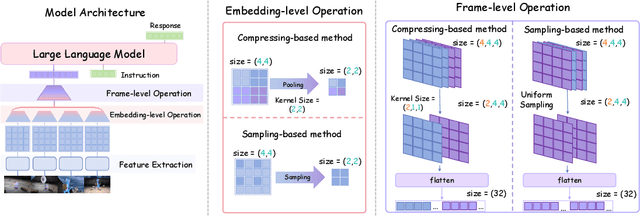

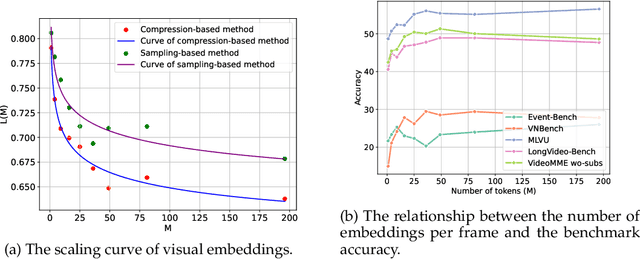

Abstract:Video Multimodal Large Language Models (MLLMs) have shown remarkable capability of understanding the video semantics on various downstream tasks. Despite the advancements, there is still a lack of systematic research on visual context representation, which refers to the scheme to select frames from a video and further select the tokens from a frame. In this paper, we explore the design space for visual context representation, and aim to improve the performance of video MLLMs by finding more effective representation schemes. Firstly, we formulate the task of visual context representation as a constrained optimization problem, and model the language modeling loss as a function of the number of frames and the number of embeddings (or tokens) per frame, given the maximum visual context window size. Then, we explore the scaling effects in frame selection and token selection respectively, and fit the corresponding function curve by conducting extensive empirical experiments. We examine the effectiveness of typical selection strategies and present empirical findings to determine the two factors. Furthermore, we study the joint effect of frame selection and token selection, and derive the optimal formula for determining the two factors. We demonstrate that the derived optimal settings show alignment with the best-performed results of empirical experiments. Our code and model are available at: https://github.com/RUCAIBox/Opt-Visor.
Towards Event-oriented Long Video Understanding
Jun 20, 2024Abstract:With the rapid development of video Multimodal Large Language Models (MLLMs), numerous benchmarks have been proposed to assess their video understanding capability. However, due to the lack of rich events in the videos, these datasets may suffer from the short-cut bias that the answers can be deduced from a few frames, without the need to watch the entire video. To address this issue, we introduce Event-Bench, an event-oriented long video understanding benchmark built on existing datasets and human annotations. Event-Bench includes six event-related tasks and 2,190 test instances to comprehensively evaluate video event understanding ability. Additionally, we propose Video Instruction Merging~(VIM), a cost-effective method that enhances video MLLMs using merged, event-intensive video instructions, addressing the scarcity of human-annotated, event-intensive data. Extensive experiments show that the best-performing model, GPT-4o, achieves an overall accuracy of 53.33, significantly outperforming the best open-source model by 41.42%. Leveraging an effective instruction synthesis method and an adaptive model architecture, VIM surpasses both state-of-the-art open-source models and GPT-4V on the Event-Bench. All code, data, and models are publicly available at https://github.com/RUCAIBox/Event-Bench.
Needle In A Video Haystack: A Scalable Synthetic Framework for Benchmarking Video MLLMs
Jun 13, 2024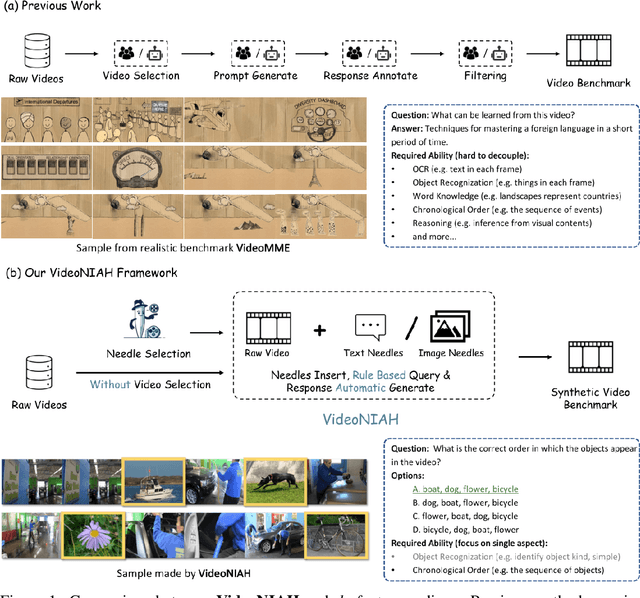
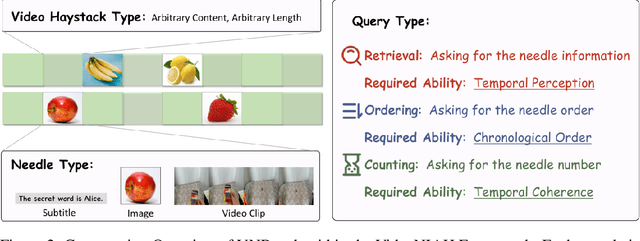
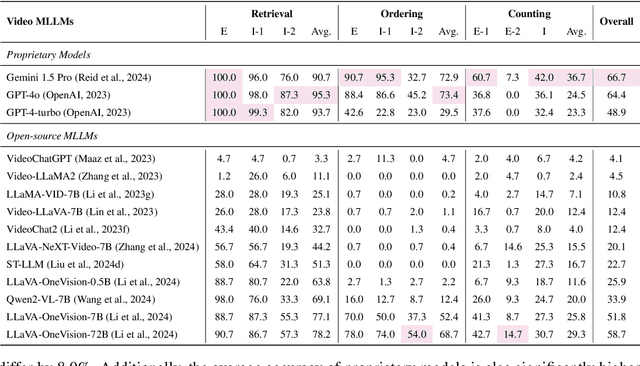
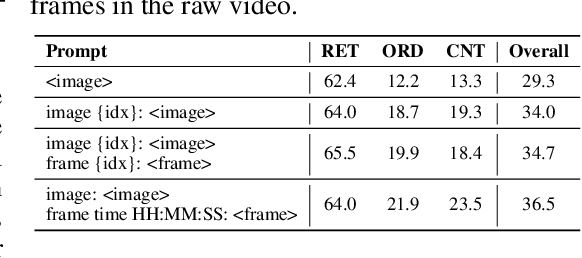
Abstract:Video understanding is a crucial next step for multimodal large language models (MLLMs). To probe specific aspects of video understanding ability, existing video benchmarks typically require careful video selection based on the target capability, along with laborious annotation of query-response pairs to match the specific video content. This process is both challenging and resource-intensive. In this paper, we propose VideoNIAH (Video Needle In A Haystack), a benchmark construction framework through synthetic video generation. VideoNIAH decouples test video content from their query-responses by inserting unrelated image/text 'needles' into original videos. It generates annotations solely from these needles, ensuring diversity in video sources and a variety of query-responses. Additionally, by inserting multiple needles, VideoNIAH rigorously evaluates the temporal understanding capabilities of models. We utilized VideoNIAH to compile a video benchmark VNBench, including tasks such as retrieval, ordering, and counting. VNBench can efficiently evaluate the fine-grained understanding ability and spatio-temporal modeling ability of a video model, while also supporting the long-context evaluation. Additionally, we evaluated recent video-centric multimodal large language models (MLLMs), both open-source and proprietary, providing a comprehensive analysis. We found that although proprietary models have significant advantages over open-source models, all existing video models still perform poorly on long-distance dependency tasks. VideoNIAH is a simple yet highly scalable benchmark construction framework, and we believe it will inspire future video benchmark works. The code and data are available at https://github.com/joez17/VideoNIAH.
What Makes for Good Visual Instructions? Synthesizing Complex Visual Reasoning Instructions for Visual Instruction Tuning
Nov 02, 2023Abstract:Visual instruction tuning is an essential approach to improving the zero-shot generalization capability of Multi-modal Large Language Models (MLLMs). A surge of visual instruction datasets with various focuses and characteristics have been proposed recently, enabling MLLMs to achieve surprising results on evaluation benchmarks. To develop more capable MLLMs, in this paper, we aim to investigate a more fundamental question: ``what makes for good visual instructions?''. By conducting a comprehensive empirical study, we find that instructions focused on complex visual reasoning tasks are particularly effective in improving the performance of MLLMs on evaluation benchmarks. Building upon this finding, we design a systematic approach to automatically creating high-quality complex visual reasoning instructions. Our approach employs a synthesis-complication-reformulation paradigm, leveraging multiple stages to gradually increase the complexity of the instructions while guaranteeing quality. Based on this approach, we create the synthetic visual reasoning instruction dataset consisting of 32K examples, namely ComVint, and fine-tune four MLLMs on it. Experimental results demonstrate that our dataset consistently enhances the performance of all the compared MLLMs, e.g., improving the performance of MiniGPT-4 and BLIP-2 on MME-Cognition by 32.6% and 28.8%, respectively. Our code and data are publicly available at the link: https://github.com/RUCAIBox/ComVint.
Learning to Imagine: Visually-Augmented Natural Language Generation
Jun 04, 2023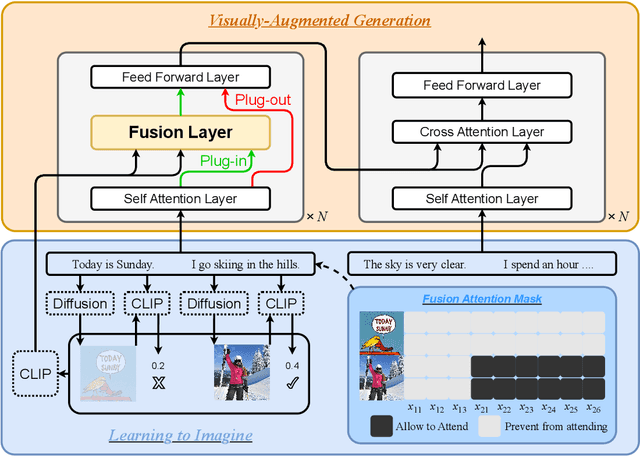

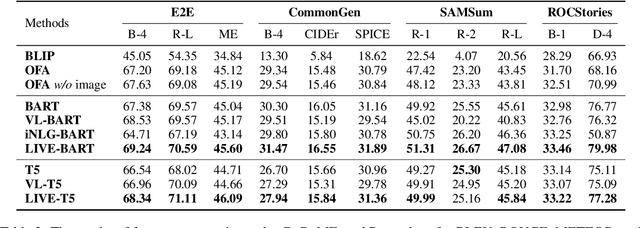
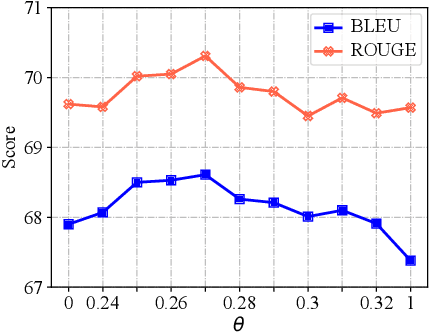
Abstract:People often imagine relevant scenes to aid in the writing process. In this work, we aim to utilize visual information for composition in the same manner as humans. We propose a method, LIVE, that makes pre-trained language models (PLMs) Learn to Imagine for Visuallyaugmented natural language gEneration. First, we imagine the scene based on the text: we use a diffusion model to synthesize high-quality images conditioned on the input texts. Second, we use CLIP to determine whether the text can evoke the imagination in a posterior way. Finally, our imagination is dynamic, and we conduct synthesis for each sentence rather than generate only one image for an entire paragraph. Technically, we propose a novel plug-and-play fusion layer to obtain visually-augmented representations for each text. Our vision-text fusion layer is compatible with Transformerbased architecture. We have conducted extensive experiments on four generation tasks using BART and T5, and the automatic results and human evaluation demonstrate the effectiveness of our proposed method. We will release the code, model, and data at the link: https://github.com/RUCAIBox/LIVE.
Zero-shot Visual Question Answering with Language Model Feedback
May 26, 2023Abstract:In this paper, we propose a novel language model guided captioning approach, LAMOC, for knowledge-based visual question answering (VQA). Our approach employs the generated captions by a captioning model as the context of an answer prediction model, which is a Pre-trained Language model (PLM). As the major contribution, we leverage the guidance and feedback of the prediction model to improve the capability of the captioning model. In this way, the captioning model can become aware of the task goal and information need from the PLM. To develop our approach, we design two specific training stages, where the first stage adapts the captioning model to the prediction model (selecting more suitable caption propositions for training) and the second stage tunes the captioning model according to the task goal (learning from feedback of the PLM). Extensive experiments demonstrate the effectiveness of the proposed approach on the knowledge-based VQA task. Specifically, on the challenging A-OKVQA dataset, LAMOC outperforms several competitive zero-shot methods and even achieves comparable results to a fine-tuned VLP model. Our code is publicly available at https://github.com/RUCAIBox/LAMOC.
Evaluating Object Hallucination in Large Vision-Language Models
May 23, 2023



Abstract:Inspired by the superior language abilities of large language models (LLM), large vision-language models (LVLM) have been recently explored by integrating powerful LLMs for improving the performance on complex multimodal tasks. Despite the promising progress on LVLMs, we find that LVLMs suffer from the hallucination problem, i.e. they tend to generate objects that are inconsistent with the target images in the descriptions. To investigate it, this work presents the first systematic study on object hallucination of LVLMs. We conduct the evaluation experiments on several representative LVLMs, and show that they mostly suffer from severe object hallucination issue. We further discuss that the visual instructions may influence the hallucination, and find that: objects that frequently occur in the visual instructions or co-occur with the image objects, are obviously prone to be hallucinated by LVLMs. Besides, we find that existing evaluation methods might be affected by the input instructions and generation styles of LVLMs. Thus, we further design an improved evaluation method for object hallucination by proposing a polling-based query method called POPE. Experiment results demonstrate that our POPE can evaluate the object hallucination in a more stable and flexible way. Our codes and data are publicly available at https://github.com/RUCAIBox/POPE.
A Survey of Large Language Models
Apr 27, 2023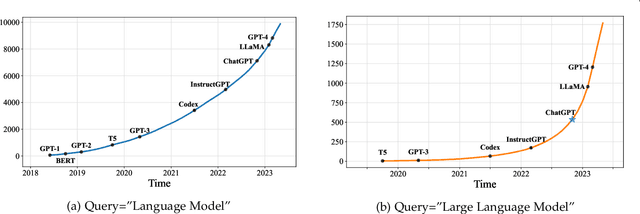

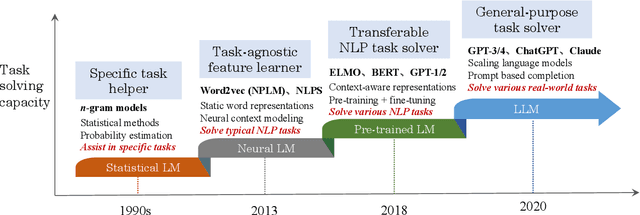

Abstract:Language is essentially a complex, intricate system of human expressions governed by grammatical rules. It poses a significant challenge to develop capable AI algorithms for comprehending and grasping a language. As a major approach, language modeling has been widely studied for language understanding and generation in the past two decades, evolving from statistical language models to neural language models. Recently, pre-trained language models (PLMs) have been proposed by pre-training Transformer models over large-scale corpora, showing strong capabilities in solving various NLP tasks. Since researchers have found that model scaling can lead to performance improvement, they further study the scaling effect by increasing the model size to an even larger size. Interestingly, when the parameter scale exceeds a certain level, these enlarged language models not only achieve a significant performance improvement but also show some special abilities that are not present in small-scale language models. To discriminate the difference in parameter scale, the research community has coined the term large language models (LLM) for the PLMs of significant size. Recently, the research on LLMs has been largely advanced by both academia and industry, and a remarkable progress is the launch of ChatGPT, which has attracted widespread attention from society. The technical evolution of LLMs has been making an important impact on the entire AI community, which would revolutionize the way how we develop and use AI algorithms. In this survey, we review the recent advances of LLMs by introducing the background, key findings, and mainstream techniques. In particular, we focus on four major aspects of LLMs, namely pre-training, adaptation tuning, utilization, and capacity evaluation. Besides, we also summarize the available resources for developing LLMs and discuss the remaining issues for future directions.
A Survey of Vision-Language Pre-Trained Models
Feb 18, 2022


Abstract:As Transformer evolved, pre-trained models have advanced at a breakneck pace in recent years. They have dominated the mainstream techniques in natural language processing (NLP) and computer vision (CV). How to adapt pre-training to the field of Vision-and-Language (V-L) learning and improve the performance on downstream tasks becomes a focus of multimodal learning. In this paper, we review the recent progress in Vision-Language Pre-Trained Models (VL-PTMs). As the core content, we first briefly introduce several ways to encode raw images and texts to single-modal embeddings before pre-training. Then, we dive into the mainstream architectures of VL-PTMs in modeling the interaction between text and image representations. We further present widely-used pre-training tasks, after which we introduce some common downstream tasks. We finally conclude this paper and present some promising research directions. Our survey aims to provide multimodal researchers a synthesis and pointer to related research.
 Add to Chrome
Add to Chrome Add to Firefox
Add to Firefox Add to Edge
Add to Edge